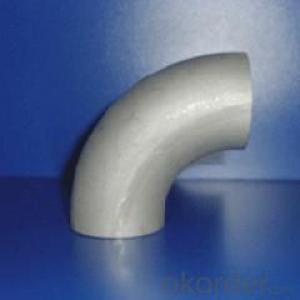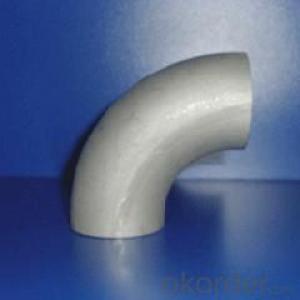Bosch Profiles Aluminum 60 Degree Aluminum Elbow
- Loading Port:
- China Main Port
- Payment Terms:
- TT OR LC
- Min Order Qty:
- -
- Supply Capability:
- -
OKorder Service Pledge
OKorder Financial Service
You Might Also Like
Specifications
60 degree aluminum elbow
1.size:1/2"-48"
2.standard:ASTM B16.9
3.Certification: ISO
Type | 60 degree elbow |
Size | 1/2"-48"DN15--DN1200 |
Wall Thickness | Sch5--Sch160XXS |
Standard | ISO, SNSI, JIS, DIN, GB/T12459GB/T13401ASME B16.9SH3408 SH3409HG/T21635HG/T21631SY/T05010 |
Material | 20#/Q235 |
Packaging | wooden cases or wooden pallet or as per customers requirement |
Applications Range | petroleum, chemical, power, gas, metallurgy, shipbuilding, construction, etc |
Min Order Quantity | According to customer's requirement |
Delivery Time | According to customer's requirement |
Quality | First grade |
Productivity | 8000000T/Y |
Others | 1.Special design available according to requirement 2.Anti-corrosion and high-temperature resistant with black painting 3. All the production process are made under the ISO9001:2008 strictly. |
- Q: How do aluminum profiles perform in terms of heat resistance?
- Aluminum profiles generally exhibit good heat resistance. Aluminum has a high thermal conductivity, allowing it to efficiently dissipate heat. Additionally, aluminum profiles can withstand high temperatures without deforming or losing structural integrity. However, extreme temperatures, especially above 600°C, can cause aluminum to gradually lose strength. Therefore, it is important to consider the specific application and temperature requirements when evaluating the heat resistance of aluminum profiles.
- Q: This question asks for a list of various uses of aluminum profiles within the construction industry.
- <p>Aluminum profiles have a wide range of applications in the construction industry due to their strength, durability, and lightweight properties. They are used in window and door frames for their resistance to corrosion and ease of maintenance. They are also employed in curtain walls, which are the outer coverings of buildings, providing both aesthetic appeal and structural integrity. Aluminum profiles are utilized in the construction of scaffolding for their high strength-to-weight ratio, ensuring safety and stability. Additionally, they are used in the manufacturing of modular buildings and prefabricated structures due to their ease of assembly and disassembly. Other applications include roofing systems, flooring structures, and as support beams in various construction projects.</p>
- Q: This question asks for methods to prevent corrosion on aluminum profiles during the installation process.
- <p>To prevent corrosion of aluminum profiles during installation, follow these steps: 1. Use stainless steel fasteners and avoid galvanized or carbon steel screws which can cause galvanic corrosion. 2. Keep the aluminum profiles clean and dry during installation to avoid contact with moisture which can initiate corrosion. 3. Apply a protective coating or sealant to the profiles, especially at cut edges where the protective oxide layer may be compromised. 4. Store aluminum profiles in a dry, cool place before installation to prevent moisture absorption. 5. Regularly inspect and maintain the profiles to identify and address any signs of corrosion early. By adhering to these practices, you can significantly reduce the risk of corrosion on aluminum profiles during installation.</p>
- Q: Shanghai industrial aluminum profile manufacturers which is better?
- How to choose the industrial aluminum profiles, this problem for the just contact with industrial aluminum profile friends, is really a serious problem to consider.That selection of industrial aluminum manufacturers is not good, money, goods is not good, he can give you redo is OK, but also take time; meet industrial aluminum manufacturers some black, and you may be wrangling, that egg pain.
- Q: This question asks for methods to guarantee the reliability of aluminum profiles used in a construction project.
- <p>To ensure the quality of aluminum profiles in your building project, first, source from reputable suppliers with a proven track record. Request for certifications such as ISO 9001 for quality management systems. Inspect the profiles for uniformity in thickness and straightness. Check for surface defects like scratches or dents. Ensure the profiles meet the required strength and durability standards by requesting test reports or conducting your own tests. Verify the alloy composition to ensure it's suitable for your project's environmental conditions. Lastly, consider the manufacturer's warranty and after-sales service as an indicator of their confidence in product quality.</p>
- Q: Are aluminum profiles suitable for use in roofing or wall systems?
- <p>Yes, aluminum profiles are commonly used for both roofing and wall systems due to their durability, corrosion resistance, and lightweight properties. They offer a modern aesthetic and can be easily integrated into various architectural designs. Aluminum profiles are also known for their strength and flexibility, allowing for the creation of complex shapes and structures. Additionally, they require minimal maintenance and can withstand harsh weather conditions, making them a popular choice for construction projects.</p>
- Q: Can aluminum profiles be used in solar mounting systems?
- Yes, aluminum profiles can be used in solar mounting systems. Aluminum is a popular choice for solar mounting systems due to its lightweight, durability, and corrosion resistance properties. It is also easy to fabricate and install, making it an ideal material for constructing solar panel frames, rails, and supports. Additionally, aluminum profiles can be easily recycled, making them an environmentally friendly choice for solar mounting systems. Overall, aluminum profiles are a reliable and efficient option for solar mounting systems.
- Q: Are aluminum profiles suitable for use in flooring systems?
- <p>Yes, aluminum profiles can be used for flooring systems. They are known for their strength, durability, and resistance to corrosion, making them ideal for various flooring applications. Aluminum profiles can be used to create modular flooring systems, providing a lightweight and easy-to-install solution. They can also be used in conjunction with other materials to create hybrid flooring systems, offering a combination of benefits such as thermal insulation, acoustic performance, and structural integrity.</p>
- Q: Are aluminum profiles suitable for use in exterior wall insulation systems?
- <p>Yes, aluminum profiles can be used for exterior wall insulation systems. They are known for their durability, resistance to corrosion, and ability to withstand various weather conditions. Aluminum profiles provide a strong structural framework that can support insulation materials effectively. They are also lightweight, which makes them easy to handle and install. Additionally, aluminum profiles can be anodized or coated to enhance their resistance to environmental factors, making them a popular choice for exterior insulation systems.</p>
- Q: Is aluminum alloy made of industrial aluminum?
- Two, according to the alloy can be divided into 1024 categories: a 2011, 6063, 6061, 6082, 7075 grade aluminum alloy, which is the 6 most common. Grades are different in various metal components ratio is not the same, in addition to the usual windows In addition to aluminum such as the 60 series, 70 series, 80 series, 90 series, curtain wall series aluminum profile, aluminum industry has no clear distinction model, most manufacturers are in accordance with the actual drawings processing customer.
Send your message to us
Bosch Profiles Aluminum 60 Degree Aluminum Elbow
- Loading Port:
- China Main Port
- Payment Terms:
- TT OR LC
- Min Order Qty:
- -
- Supply Capability:
- -
OKorder Service Pledge
OKorder Financial Service
Similar products
Hot products
Hot Searches
Related keywords























